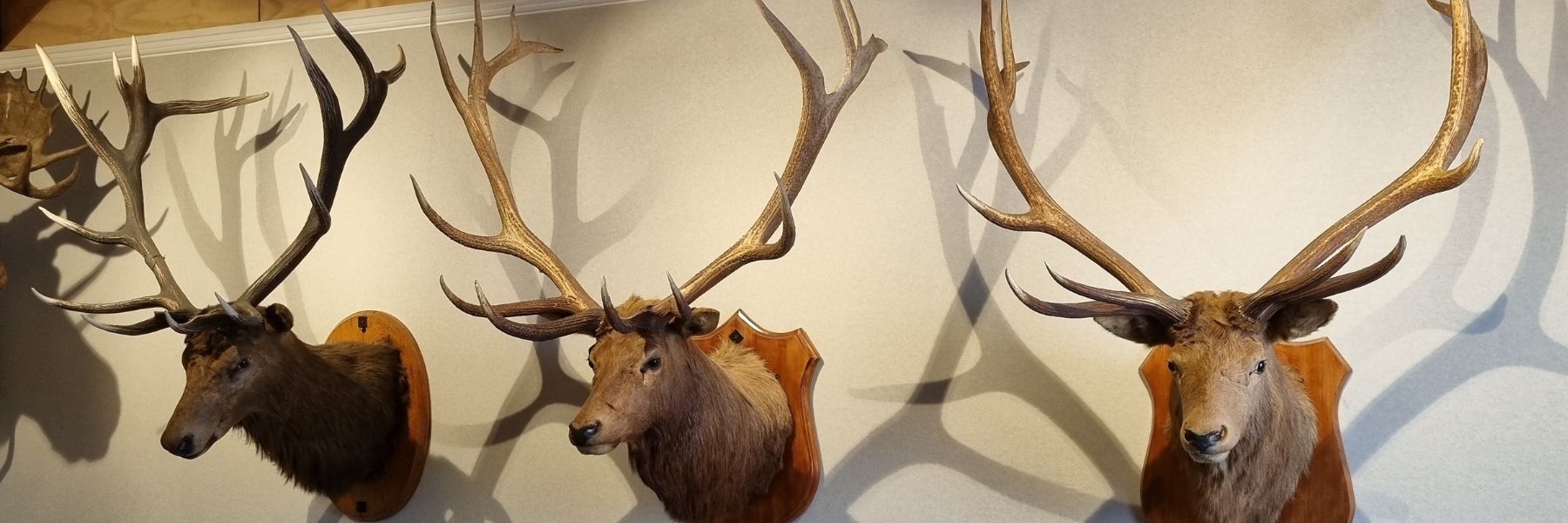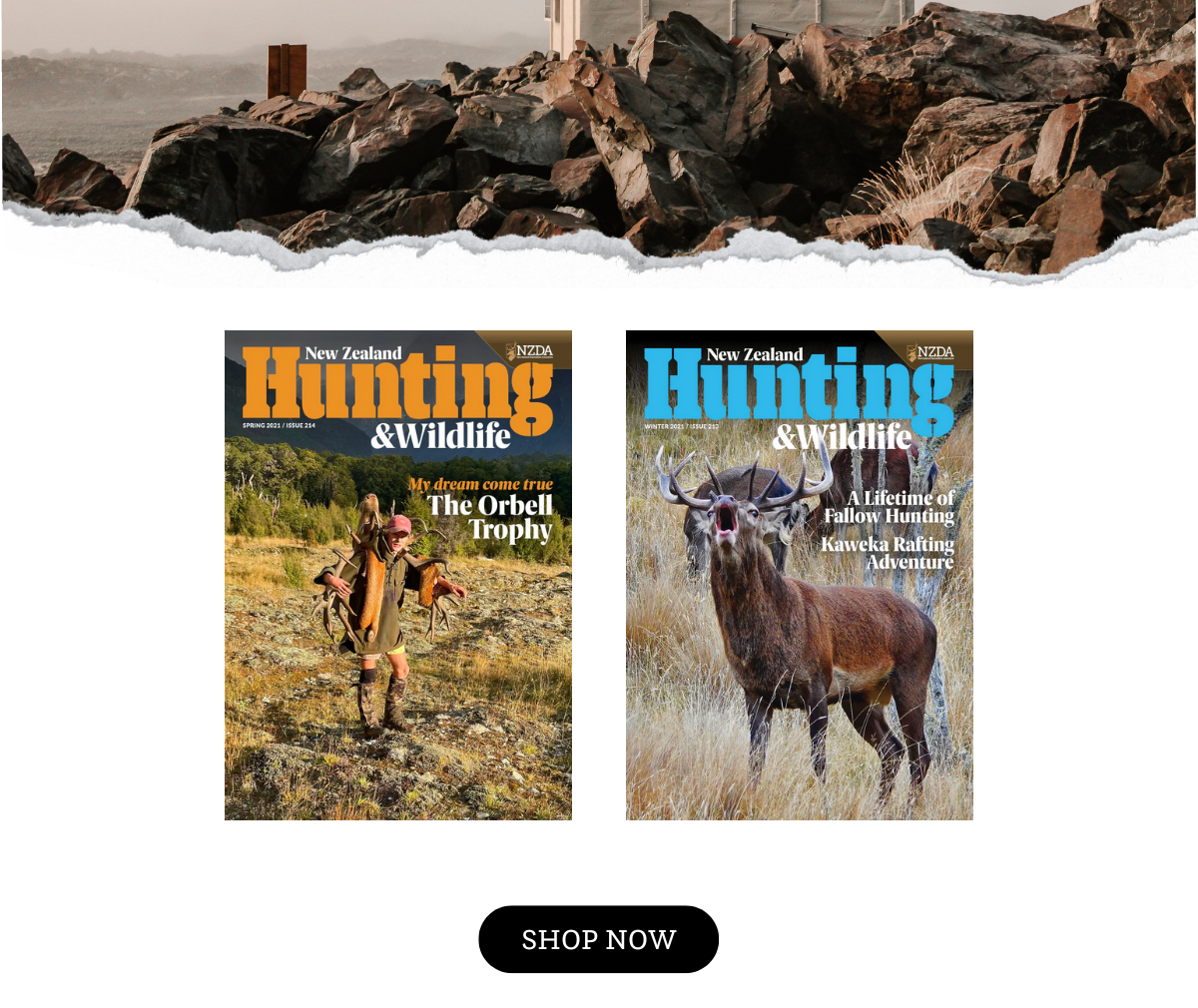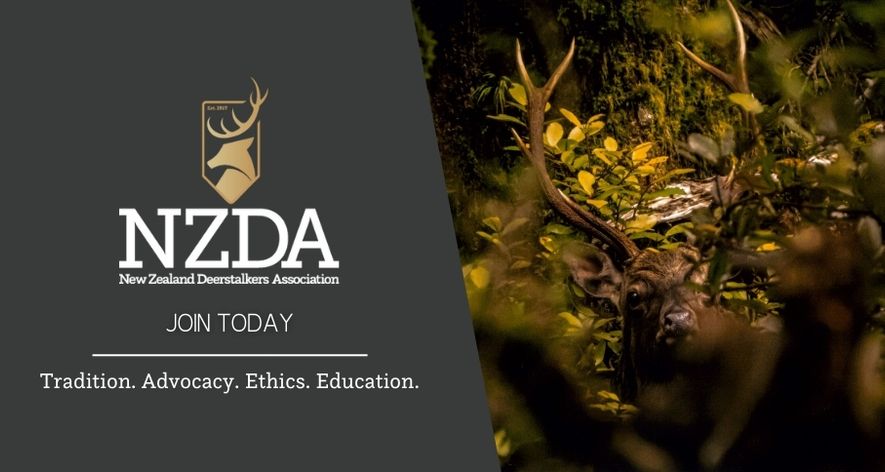28 August 2023
Hunting and Wildlife Magazine - Winter Issue 221
Words By: Simon Gibson
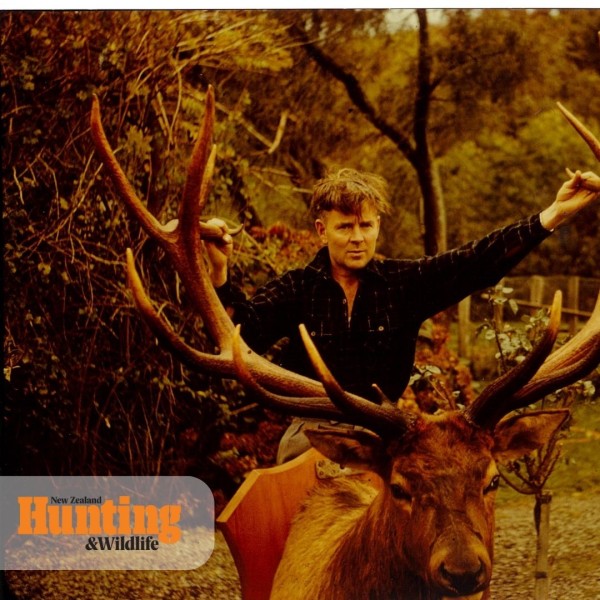
Phil Maurice’s great wapiti head is listed at No 3 in the record books. Taken 1952 in Kakapo Creek off the Glaisnock River, the head measures 53½ inches by 58⅞ inches, 16 points, Douglas Score 467⅝.
Fiordland National Park located on the south-western corner of New Zealand’s South Island encompasses 1,221,320 hectares of rugged rain forest and is home to the New Zealand wapiti herd. The recognised area wapiti inhabit stretches from Charles Sound in the south up to Sutherland Sound and the Worsley River to the north and encompasses an area of some 175,000 hectares. Located towards the northern end of the National Park, the wapiti area contains some of the most broken, roughest and steepest terrain. Annual rainfall can be anywhere from 6½metres on the western coastal areas to over 8 metres on the more inland areas around the main divide.
The first wapiti to arrive on the shores of New Zealand, a cow and bull were imported in 1873 by the then Governor of New Zealand, Sir George Grey who lived on Kawau Island in the Hauraki Gulf. After they were released on the island, the cow died and the bull was later shot after it became increasingly aggressive. Not long after this another bull and a pregnant cow were brought to New Zealand by the captain of an American timber vessel, however before they reached Dunedin the bull died. Shortly after landing the cow gave birth but died leaving only the bull calf. After being kept as a pet, on maturity he was released into the hills behind Dunedin and was eventually shot on Flagstaff Hill in the early 1880’s. The head he carried was of trophy class measuring 50⅝ inches in length with a spread of 55 inches, 17 points and a Douglas Score of 440⅜.
On the 3rd of March 1905, the present Fiordland wapiti herd came into existence when the Government vessel Hinemoa unloaded 18 wapiti onto the shores of what is now known as the Lake Katherine Block at the head of George Sound. Their difficult journey to New Zealand was organised by T. E. Donne, the then manager of the New Zealand Government Tourism Department and Mr St. George Littledale a well-known big game hunter of the time from England. Littledale met Donne in 1902 when he visited New Zealand and was very enthusiastic about the importation of game animals that Donne was organising. On his return to England, he organised the shipment of 6 Himalayan tahr from the Woburn Estate of the Duke of Bedford. Five of these animals were eventually released near the Hermitage at Mt Cook.
Encouraged by his success, Littledale approached the then President of the United States of America, Theodore Roosevelt and arranged with him that New Zealand would receive 10 wapiti from the National Zoological Park in Washington, DC. In exchange, rare New Zealand birds, tuatara and some European game animals, preferably chamois were to be sent to the park. The exchange of animals was a formality to comply with the law controlling the administration of the park which forbade it giving animals away. The request for chamois could not be met as the New Zealand Government could not source any at the time so it was arranged for a shipment of roe deer from England to be sent instead. Donne travelled to America in late 1904 to arrange the shipment of wapiti to New Zealand and while there he met President Roosevelt several times. President Roosevelt showed great interest in New Zealand and instructed American Government officials to give Donne any assistance he needed. Donne then purchased another 10 wapiti from H.E. Richardson of the Indian Game Reserve in Massachusetts.
He then went on to purchase 22 whitetail deer, 5 mule deer, 50 Canada geese and a variety of other waterfowl and geese, several types of owls and 5 racoons.
On the invitation of Dr. Frank Baker, the Superintendent of the National Zoological Park in Washington, all the animals Donne had purchased were assembled there and placed in crates of Donne’s design ready for their long journey to New Zealand along with the various kinds of food needed. Two steam heated wagons were used to transport the large consignment on the 7-day, 5000-kilometre journey to San Francisco where it was to be loaded onto a ship. Once in San Francisco several seemly insurmountable problems arose for Fred Moorhouse from the New Zealand Tourism Department who had been tasked with shipping the animals. The shipping company refused to carry the shipment on the intended vessel and wanted to hold it for three weeks and to add to the problems the pre-payment of the freight had not been made by the New Zealand Government. Donne who was now in New York, paid for the freight himself and after much telegraphing to the shipping company the problems were resolved. The animals then left on their 10,000-kilometre journey to New Zealand. They were on the open decks of the ship and when nearing New Zealand bad weather was encountered and two of the wapiti died from broken backs.
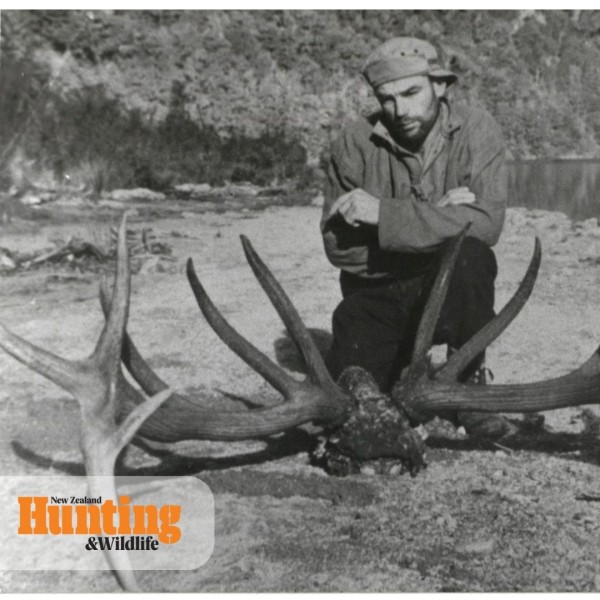
Phil Maurice’s great head on the Glaisnock beach, North Arm of Lake Te Anau, shows its immense size. Pictured is Maurice’s hunting companion, Vince Kappley.
On their arrival the remaining 18 wapiti were transferred to the Government vessel Hinemoa and taken to the head of George Sound and released. Donne had no say in where they were to be released. He travelled to their release point on the Hinemoa in 1909 where he found plenty of tracking from young wapiti and calves. A large antlered bull was observed at close range and given his lack of fear of humans was doubtless one of the original bulls released.
The head of George Sound was at the time very remote and only visited by the occasional fisherman, so the herd was left relatively undisturbed. In 1921 with a view to ascertaining whether the wapiti in George Sound and the moose which were released in Dusky Sound in 1910 had become established, the Government sent Inspector Fred Moorhouse who was at the time conservator of fish and game at Rotorua to survey the area. He was accompanied by J. K. Wadsworth representing the Southland Acclimatisation Society and a photographer L Hinge. Leaving Bluff for George Sound on the 12th of February 1921 aboard the motor vessel Britannia, the party arrived a week later after being delayed by gales. It soon became apparent when surveying the area around Lake Katherine that the wapiti had thrived as tracking was well established and several animals were seen. The party then proceeded to Caswell Sound where they spent time looking for sign of wapiti around the southern end of Lake Marchant, again it was obvious the wapiti were thriving and their range increasing.
In December 1921 the Southland Acclimatisation Society sent a ranger, C. J. Evans to investigate whether the wapiti had spread over onto the eastern side of the range. The Henry Saddle at the head of the Rugged Burn was an obvious route for them to spread into the Rugged Burn and Wapiti River areas. Evans travelled to the head of the North West Arm of the Middle Fiord of Lake Te Anau and from there travelled up Lake Hankinson by canoe. Fresh deer sign and a wapiti bull were seen several kilometres up the valley from Lake Hankinson and above Lake Thomson plentiful deer sign was seen leading him to surmise that the valley held a herd of twenty or so wapiti. The Southwest Arm of the Middle Fiord was also explored but no sign of deer was seen there.
When the Prime Minister of the time, the Rt Hon W. F. Massey visited Invercargill in 1922, the Southland Acclimatisation asked that a hunting season be held in 1923 with two licences to be issued with a fee of £10 being charged for each. This was eventually agreed to and after keen competition the first licences to hunt wapiti in New Zealand were issued to Vivian Donald of Masterton and Leslie Murrell from Manapouri. On arriving at the bottom of Lake Katherine on the 11th of April, they spotted a good bull lying on a sandy beach at the head of the lake. After several hours of hard going around the side of the lake Donald took the bull cleanly with a 350-yard shot using his .280 Ross rifle. The bull proved to be a cracker sporting 14 points, a length of 54¾ inches and spread of 47¼ inches and scored 411¼DS.
A special permit was also issued to H. Beer and G. P. Chewings from Mossburn to survey the area above Lake Hankinson for wapiti numbers and in return they were allowed to take one trophy if the opportunity arose. While they saw sign of wapiti and picked up a cast antler, they were unsuccessful in sighting any animals.
While these were the first official licences issued there were already several known cases of wapiti being poached from the head of George Sound. One of these involved the redoubtable Park brothers who had many adventures in the area. They put into George Sound aboard their 15-ton ketch the Wakaiti in July 1910 after meeting rough weather on a voyage from Hokitika. James Park’s son Hugh and his mate Samuel Preston took a shotgun and a .22 rifle and tramped firstly to Lake Alice and then to Lake Katherine where they saw a large deer browsing on the lake shore. Preston fired both barrels of the shotgun into the shoulder while Park fired the .22 into the head and probably the first wapiti shot by anyone in Fiordland crashed dead into the lake.
The following year, seven licences were issued, and the area was divided into three blocks, George Sound, Caswell Sound and Lake Hankinson. The famous hunter Eddie Herrick along with his wife Ethne enjoyed considerable success taking some superb heads. Mrs Herrick took a 47 inch long, 17 pointer at the head of Katherine Creek and the same day Eddie Herrick took a 50 inch long, 13 pointer near Lake Katherine. Herrick went on to take his greatest head ever when he secured a 58½ inch long, 46¼ inch wide, 14 pointer near what is now known as Ethne Stream. John Deans of Canterbury took the first wapiti from the eastern side of the range that same year, a 49⅝ inch long, 14 pointer from the Henry Saddle area.
In the years from 1925 until the start of the Second World War many of the great wapiti heads were taken by the likes of Major R. A. Wilson, Edgar Nitz, Mick Halberg, Ken and Alex Sutherland and Ken Dalrymple to name a few. The greatest wapiti head to ever come out of Fiordland was taken by Edgar Nitz at the head of Nitz Creek in 1933 when he secured a magnificent head measuring 57¾ inches long, 50 inches wide and with 17 points it scored 474¾DS. Also of note was the finding of a massive cast antler measuring 64½ inches in length in the Canyon Creek area in 1938.
The financial cost of hunting wapiti in the early days was considerable with the licence fee, transport, guides and a long period of time away from home putting it out of the reach of most hunters, however that was to change dramatically in the following decades.
All protection for New Zealand’s wild deer herds was removed in 1934 by the Government because of concerns over rapidly rising animal numbers. The wapiti areas remoteness and the onset of the Second World War meant little changed except that hunters no longer had to pay hefty licence fees. During the war years, very little hunting was carried out in the more inaccessible parts of the wapiti area and the animals were left relatively undisturbed, so their numbers continued to build. The exception to this was the activities of professional skin hunters who at the time were making good money from the sale of deer skins and with wapiti hides being twice the weight of a red deer they were in big demand. Joff Thompson whose exploits in the area were immortalised in his classic book “Deer Hunter” spent time in the Glaisnock and Doon areas taking a number of wapiti. The terrain and distances required to get green skins weighing up to 20kgs each out of the bush presented many problems. His activities and those of the twenty or so other skin hunters operating in the area at the time caused considerable angst amongst wapiti hunters, however their actions were completely legal.
After the war years there was great social and economic change in New Zealand and a new breed of hunter started entering the wapiti blocks. They were self-sufficient and hunted without the aid of guides, so wapiti hunting was now within the reach of the average man. The arrival of float planes in Te Anau in the early fifties and the ability to carry out air drops greatly aided hunters heading into the more remote blocks, sometimes for periods of up to six weeks. The period from the late forties to the mid fifties was a halcyon era for wapiti hunters. Big bulls had been able to mature in the head basins with little disturbance from hunters and during this period many of the great wapiti heads were taken. Phil Maurice took the second biggest wapiti ever taken in New Zealand when he downed a 55⅜ x 59 inch, 16 pointer in the head of Kakapo Creek in 1952. Then there was Don Malcolm’s great 54¼ x 49 inch, 17 point head which ranks at No 4 in the record books, taken from the Castle River in the Worsley Valley in 1950. And let’s not forget Jack Luttrell’s 58⅝ x 41¼ inch, 14 pointer from Dream Bull Basin, along with several other big heads he took in 1949.
It was during this period that some major events and changes took place in the wapiti area. Official Wildlife Department deer destruction parties shot 118 wapiti, crossbreeds and red deer in the areas accessible from the North and Middle Fiords during the 1948/49 season. The rediscovery of Takahe in the Murchison Mountains to the south of the wapiti blocks in 1948 by Dr Geoffrey Orbell saw the area closed off to recreational hunters and a big build up of red deer occurred which infiltrated into the southern wapiti blocks until Government shooters lowered their numbers. The New Zealand-American Fiordland Expedition took place in the Stillwater area in 1949 looking at how the American wapiti had adapted to New Zealand conditions and any possible crossbreeding.
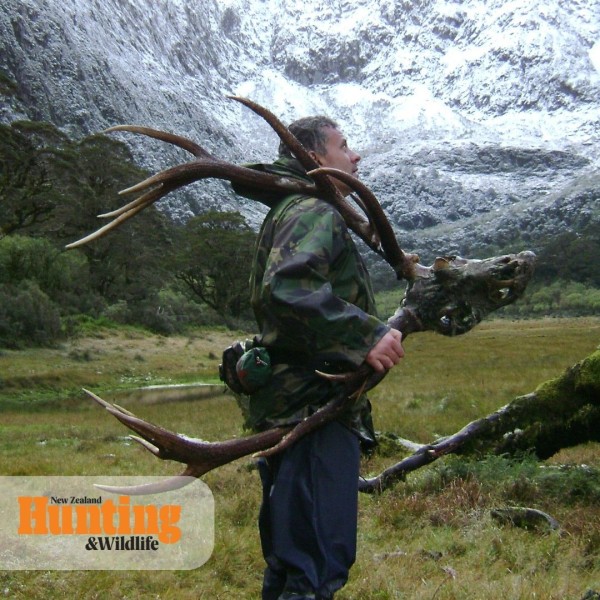
In 2008, the first head in 38 years measuring over 50 inches in length was taken by James Bell in the Wapiti River block. 50¾ x 43, 15-points, DS 389¾. Pictured is Pirita Church.
In 1952 the National Parks Act was passed which called for the extermination of all introduced species in Fiordland National Park and then in 1956 the Noxious Animals Act was passed which listed wapiti and so started a battle by hunters to save the herd which has continued to the present day.
If this wasn’t enough, all was not well in the wapiti blocks. When wapiti were first released in George Sound in 1905, they were of course pure wapiti, however releases of red deer by the Southland Acclimatisation Society around the same time at the Hope Arm of Lake Manapouri, Dusky Sound in 1909 and earlier liberations at Lake Wakatipu were to ultimately doom the wapiti herd’s pure strain. Early liberations of red deer carried out by Acclimatisation Society’s were done with the best of intentions however there was a tragic lack of knowledge about the consequences of liberating different strains of red deer and in the case of the wapiti, liberating red deer nearby despite crossbreeding between the two being known and practiced in Europe and England. As early as 1932 there was a report of possible crossbreeding when the well-known stalker, Alex Sutherland reported seeing a deer that didn’t seem to be wapiti or red in the Lake Hankinson area, however red deer were still only present in the wapiti area in low numbers.
The wapiti range increased at a very slow rate due to the rugged nature of the terrain, estimated to be 0.64km a year and by the early 1950’s had extended to the Worsley Valley to the north and the Irene Valley to the south. This coincided with an invasion of red deer from the north and south and the wapiti herd has never spread further than this. There have of course been animals seen considerable distances from the recognised range of the wapiti. The most famous of these was when D. B. Shand was hunting the Eglinton Valley in 1924 and shot a 53¾ inch long, 14 pointer on the flats near the junction of the east and west branch. This was the only wapiti ever seen in this locality.
The more aggressive and adaptive red deer was rapidly extending its range, but it wasn’t until the late fifties and early sixties that red deer over-ran the wapiti area and the pure wapiti strain declined as crossbreeding watered down the genetic purity of the wapiti herd.
The threat from red deer and the general build-up of deer numbers along with the stress the habitat was under was recognised by many of those hunting the area in the early fifties including wapiti great Jack McKenzie. In 1953 at the suggestion of McKenzie, the first New Zealand Deerstalkers Association culling parties entered the Doon and Worsley areas. The cull was so successful that the then president of the NZDA, Newton McConochie was able to convince the National Parks Authority, which was about to embark on an all-out deer destruction campaign, to allow NZDA to carry out control work instead. This would allow a small wapiti trophy herd to be maintained. This was the first game management scheme for wapiti, and it did not find favour with many hunters who saw it as their right to hunt where and what they liked. Had this occurred, the Parks Authority would have simply moved in and the wholesale slaughter of the herd would have begun. No one could have foreseen that this is exactly what would happen in the seventies with the arrival of the helicopter venison recovery industry.
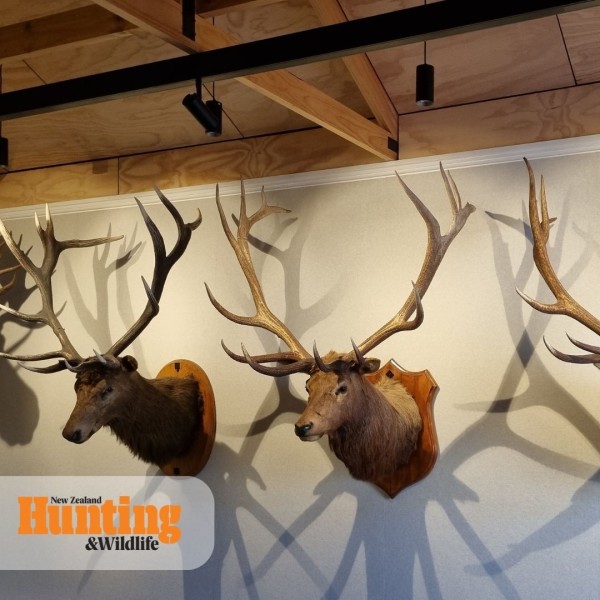
Three of the great wapiti heads can be viewed at NZDA National Office in Wellington. L-R: D. Brett Shand, Eglinton Valley 1924, 15pts, 54¾ x 44¾, DS 427⅝. Edgar Nitz, Nitz Creek 1933, 17pts, 58 x 50½, DS 474¾. Edgar Nitz, No1 in NZ record books. H.J. Nitz, Glaisnock Valley 1933, 12pts, 57 x 41⅞, DS391¼.
NZDA organised culling parties were part of the wapiti scene until the early seventies. To qualify for a hunt in the ballot you were required to spend 10 days culling in a designated block over the Christmas period. If you could not make a cull, then you were required to pay the cost of putting a man in the field. Extensive data was collected from the animals culled by ageing jaws, weighing kidneys and taking measurements of the animal’s size. During the time the NZDA ran the culling programme, it was a constant battle to stop the Fiordland Parks Board and the Forest Service starting their eradication programme. McKenzie who was now a member of the Fiordland Parks Board fought running battles with the bureaucrats and saved the day on numerous occasions for hunters.
By the mid-sixties the over-population of wapiti and red deer had depleted the feed needed for the big bulls to grow their great racks causing antler quality to plunge. At the height of the population explosion in the early seventies, antler strength was so bad it wasn’t uncommon for them to snap off as they fell after being shot.
The NZDA efforts had been gallant but the sheer size of the wapiti area and roughness of terrain combined with the weather meant control of red deer and overall deer numbers was simply not possible by ground hunters. McKenzie realised something needed to be done and he wasn’t alone in his thinking with the likes of wapiti greats Jack Luttrell and Colin Davey being in full agreement. The helicopter venison recovery industry was in full swing, and McKenzie wondered if the helicopter could be used as a tool to cull red deer from the area. He did several helicopter flights to survey the area and when he reported on the large number of deer and damage, he saw many simply did not believe him. So started a very bitter chapter in the wapiti’s history that turned hunters against each other. Long friendships were destroyed along with the wapiti herd which was slaughtered by commercial greed. After much bitter debate the first aerial cull of red deer and hybrids was held in 1970 with a large group of NZDA members and scientists from the Forest Service Research station at Rangiora along with Fiordland Parks Board staff participating as observers and collecting data from the shot animals. The aircrews were from Luggate Game Packers Limited later to be known as Alpine Helicopters Limited. During these culls there was good co-operation between the various groups. The culls carried on until 1974 and during a 10-week operation covering the whole of the wapiti area in 1973 a staggering total of 3937 red deer and hybrids were taken while purer wapiti were left. The profit from this operation was shared between the Fiordland Parks Board and Alpine Helicopters Ltd.
Poaching of the herd by other helicopter operators had become rife and had been going on well before the first official cull in 1970. They resented Alpine Helicopters being given exclusive rights to the wapiti area and a deer war broke out. Floating freezer ships moored in the fiords had helipads on their decks allowing for the quick recovery of carcasses from the surrounding hills. Ocean going jet boats were also used to run carcasses up to Milford Sound. At one stage the NZ Air Force deployed Iroquois helicopters to stop the poaching helicopters which proved futile as the slow-moving Air Force helicopters were no match for the venison recovery machines and the cunning of their pilots. Too much money was at stake and towards the end of the seventies the Parks Board sanctioned all out slaughter of the wapiti herd and McKenzie was removed from the Board after 23 years of service.
Many blame McKenzie for helicopters entering the Fiordland wapiti area but it was inevitable that this would eventually happen. In reality he prevented the all-out slaughter of the wapiti for 9 years. Just when it seemed it could not get any worse it did. Following a public outcry over what was happening the then Minister of Lands, Venn Young visited the area and had meetings with all the concerned parties. The outcome was a complete surprise to deerstalkers when the minister announced a proposal by the Parks Board to remove the remaining purer wapiti cows and breed them with imported wapiti bulls. The best animals would then be relocated to a still to be chosen area to start a new wild herd. The majority of the wapiti captured by helicopters using net guns were considered not up to standard and went to deer farms, which was probably the idea right from the start. Given the value of live deer being sold to the fledgling deer farming industry at the time, the wapiti herd was attacked from above like never before. Wapiti bulls were also captured and some of the best remaining genetics of the wapiti herd were stripped out of it. What was left of the remaining captured wapiti became the nucleus of the infamous Crown Herd which was going to be relocated. The final act in the farce came in 1987 when a new Minister of Lands, Koro Wetere announced that the Crown Herd would never be relocated or returned to Fiordland. The Crown Herd, which had built up in numbers on Evan Meredith’s Te Anau farm was then moved to the Government’s Landcorp’s Freestone farm in Manapouri where they were used for commercial purposes in building up farm bred deer herds throughout the country.
In 1993 the Fiordland Wapiti Foundation (FWF) was formed by Jack McKenzie and other concerned wapiti hunters; however they were powerless to have much influence on the herds future until nearly ten years later.
In 1995 the Minister of Conservation, Dennis Marshall announced that the Crown Herd was to be sold, enraging hunting groups who argued the herd was the property of the New Zealand sporting public. Eventually a consortium of organisations including the NZDA and Safari Club International took over control of the herd on behalf of New Zealand hunters. When the New Zealand deer farming industry crashed in 1998 the cost of maintaining the herd became prohibitive and the 383 animals were reduced considerably. Today the Crown Herd is owned by the Fiordland Wapiti Foundation and is being farmed in the Te Anau Basin on a share farming contract.
By the early nineties wapiti numbers were at a very low level and it wasn’t uncommon to hear of hunters having a helicopter hunt their block during the bugle. Applying for a wapiti block was usually successful as not many hunters wanted to go there. A brief but small bounce back in wapiti numbers occurred around the mid nineties when the wapiti area was effectively managed by the two helicopter operators shooting it, however a legal loophole saw another operator enter the blocks in 1996 and all the gains were wiped out.
Helicopter hunting in the New Zealand mountains stopped fairly abruptly in the early 2000’s when the feral venison industry collapsed after 1080 poison residue was found in carcases exported to Germany. This resulted in deer numbers building up over the following years and wapiti starting to be seen in bigger numbers. In 2002 the draft Fiordland National Park plan recommended removing all recognition of the wapiti herd and therefore finally removing a thorn that had been in the side of bureaucrats for nearly 100 years.
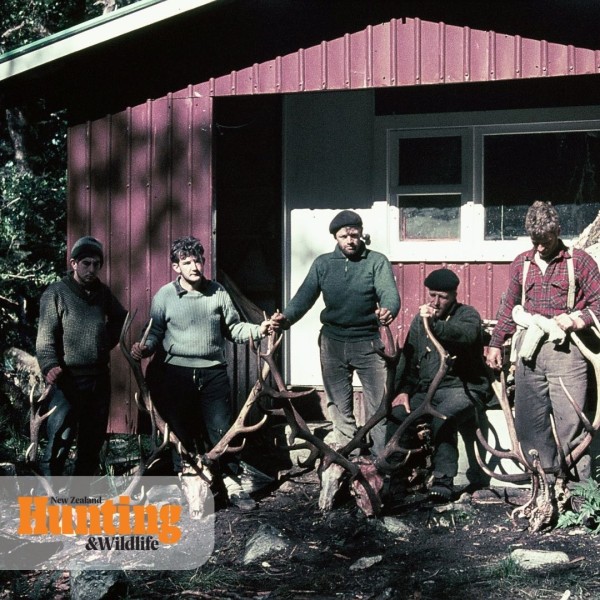
Successful hunters pictured outside the original Glaisnock Hut in the 1960s. Photo: Joe Harlock collection.
Following a public outcry, numerous meetings were held with the Department of Conservation and politicians with the end result being that the FWF stepped into the vacuum left by the collapse of the venison industry and took over administering animal control. In early 2005 an aerial search and destroy operation was carried out to get animal numbers under control and to prove to the authorities that the FWF was capable of doing the job. This caused considerable ill-feeling amongst hunters, but it had to be done.
These early deer control operations were paid for by donations from hunters. A separate entity was set up by the FWF, The Fiordland Wapiti Trust (FWT) solely to administer these funds for use in animal control operations. At first a policy of “cull and leave” was carried out but as the venison price increased in the following years the culling programme became self-funding. Profits from the venison recovery work are being shared between the FWT and the helicopter operators doing the work. The money the FWT receives is sometimes used to subsidise culling in areas where there are virtually no red deer left with the remainder being kept in reserve in case the venison price drops, and subsidised culling is needed across all blocks.
Since the FWF took over animal control in the area, many thousands of red deer, hybrids and inferior wapiti have been removed with the end result being that trophy bulls in the 45 x 45 inch class are not uncommon with a few bulls starting to push the magic fifty inch mark again. In 2008 James Bell took the first fifty inch plus head to come out of the wapiti blocks in 38 years, a 50¾ x 43 inch, 15 pointer measuring 389¾ DS from the Hankinson area.
The percentage of wapiti in trophies shot continues to increase as red deer are removed and in some areas, it is hard to find a red deer now. Deer numbers including wapiti, still need to be kept at a level where the habitat is not suffering adverse effects which is simply part of managing a herd.
In December 2011, the FWF signed off on a plan with the Department of Conservation giving the FWF control over management of the wapiti herd for the next ten years. This has since been renewed.
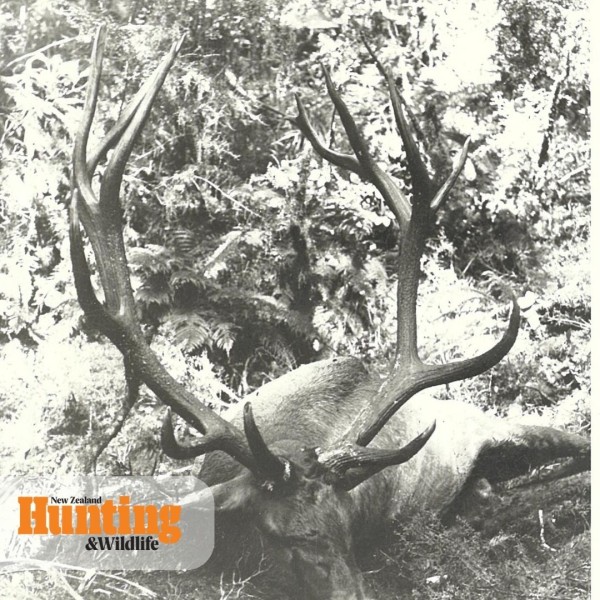
Eddie Herrick went on to take 6 wapiti trophies over a number of years. Five of these went 55 inches in length or more. His first trophy was taken on the shores of Lake Katherine in 1924, a 13-pointer measuring 50 inches in length.
In recent times, the three, 14-day ballot periods for the 25 wapiti blocks which had been in place for many years were changed to four, 10-day periods. The reality was that very few parties stayed in the blocks for the full 14-days so by reducing the period to 10-days a lot more hunters get to enjoy the Fiordland wapiti experience. The ballot is increasingly popular with New Zealand and overseas hunters with hundreds of groups applying each year. The workload for volunteers from the FWF to run the ballot, the predator control programme and deal with other wapiti related matters became unsustainable. In December 2022, the Fiordland Wapiti Foundation Committee took the step to employ professional management with a view to taking hunter led conservation and animal management in the wapiti area to the next level by announcing the appointment of Roy Sloan as the General Manager of the FWF.
Reference: Wapiti Hunting in New Zealand, Simon Gibson, 2013.
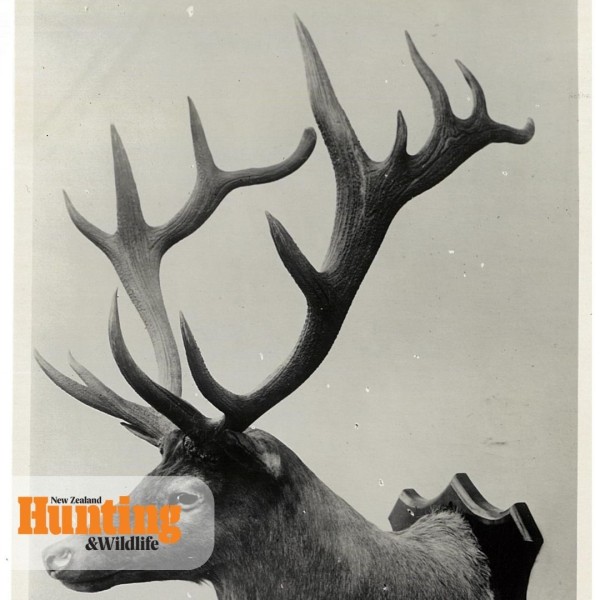
The first legal wapiti trophy was shot by Viv Donald on the shores of Lake Katherine in 1923. 54¾ x 47¼, 14 points, DS 411¼.

